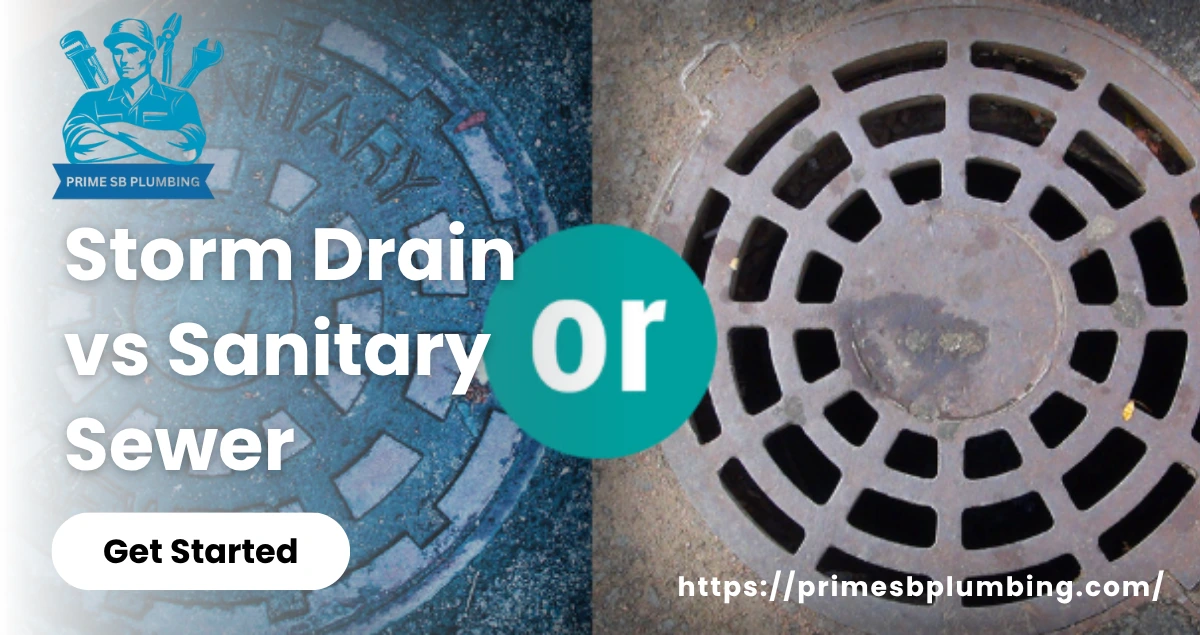Storm Drain vs Sanitary Sewer: What’s Difference

When it comes to managing wastewater and rainwater in a city or home, two important systems do the job: storm drains and sanitary sewers. These two systems may sound similar, but they serve very different purposes. Understanding the difference between a storm drain vs sanitary sewer can help you avoid plumbing problems, water pollution, and costly repairs.
If you’re a homeowner or just someone curious about how underground water systems work, this guide is here to help in simple, easy-to-understand language.
We’ll also talk about common problems that can happen with each system and how to avoid them. By the end, you’ll have a clear picture of these two essential systems and why it’s important to take care of them.
What is Storm Drain?
A storm drain is a system designed to collect rainwater and melted snow from streets, driveways, and rooftops. You’ve probably seen storm drains on the side of the road that look like metal grates. These drains help prevent flooding by moving extra water away from roads and buildings into local rivers, lakes, or the ground.
Storm drains are very important in keeping neighborhoods safe and dry during heavy rain. The water that goes into a storm drain is usually not treated. That means anything that goes into it like trash, oil, or chemicals can end up in natural water sources. So, it’s important not to dump anything into storm drains.
In the storm drain vs sanitary sewer comparison, the key point to remember is that storm drains carry clean rainwater away, while sanitary sewers carry dirty water from inside your home (like from sinks, toilets, and showers).
Common problems with storm drains
- Blockages from leaves, trash, and debris
- Flooding during heavy rain if the drain is clogged
- Pollution from harmful materials entering the drain
What is a Sanitary Sewer?
A sanitary sewer is a pipe system that carries dirty water (also called wastewater) from homes, businesses, and buildings to a treatment plant. This includes water from toilets, sinks, showers, washing machines, and dishwashers. The water travels through underground pipes to a facility where it’s cleaned before being safely released into nature.
In the storm drain vs sanitary sewer difference, the sanitary sewer is responsible for handling dirty, used water from inside buildings. Unlike storm drains, the water in sanitary sewers does get treated, making it safe before it’s returned to the environment.
Sanitary sewers play a big role in keeping communities clean and healthy. Without them, wastewater would stay in our neighborhoods and could cause serious health and pollution problems.
Common problems with sewer systems
- Clogs from grease, wipes, or foreign objects
- Tree root intrusion into underground pipes
- Pipe damage due to age or shifting ground
- Sewage backups inside homes, especially during heavy rainfall
Check More: Difference: building drain vs building sewer
Similarities Between Sanitary Sewers and Storm Sewers
When talking about storm drain vs sanitary sewer, it’s important to know that they both serve a similar purpose: moving water away from buildings and streets to keep things clean and safe. Both systems use underground pipes to carry water to another location. This helps prevent flooding, water damage, and health risks in homes and communities.
Here are some key similarities:
- Underground Pipe Systems: Both storm drains and sanitary sewers are hidden below the ground and made of durable materials like PVC or concrete.
- Water Transport: Each system is designed to move water efficiently; storm drains carry rainwater, while sanitary sewers carry used water from buildings.
- Prevent Health Hazards: If either system fails, it can lead to bad smells, flooding, or even illness. That’s why regular maintenance is important for both.
- Maintenance is Required: Over time, both systems can become blocked by debris, roots, or waste. Cleaning and inspecting them regularly can help avoid costly repairs.
Differences Between Sanitary Sewers and Storm Sewers
When comparing a storm drain vs sanitary sewer, it’s clear that they do different jobs, even though they both deal with water. Understanding the difference helps you take better care of your home and the environment.
1. Type of Water Handled
- Storm Drains carry rainwater or melted snow from streets, driveways, and sidewalks.
- Sanitary Sewers carry dirty water (called wastewater) from your home’s sinks, showers, toilets, and washing machines.
2. Where the Water Goes
- Water from storm drains usually goes directly into rivers, lakes, or oceans without treatment.
- Water from sanitary sewers goes to a wastewater treatment plant where it is cleaned before being released.
3. Source of Water
- Storm drains handle water that comes from the outside, like rain or floods.
- Sanitary sewers deal with water that comes from the inside of your house or building.
4. Risks
- Clogged storm drains can cause flooding during heavy rain.
- Blocked sanitary sewers can lead to sewage backups in your home which are dangerous and unpleasant.
Conclusion
Understanding the difference between a storm drain vs sanitary sewer is important for every homeowner and business owner. While both systems help manage water, they do very different jobs. Storm drains handle rainwater and prevent flooding, while sanitary sewers carry dirty water from your home to a treatment plant.
Knowing how these systems work can help you spot problems early like clogs, backups, or flooding and get professional help before things get worse. It also helps protect the environment by avoiding pollution from incorrect drain usage.
Whether you’re facing drainage issues or planning a new plumbing system, knowing the storm drain vs sanitary sewer difference can help you make smart and safe decisions.
